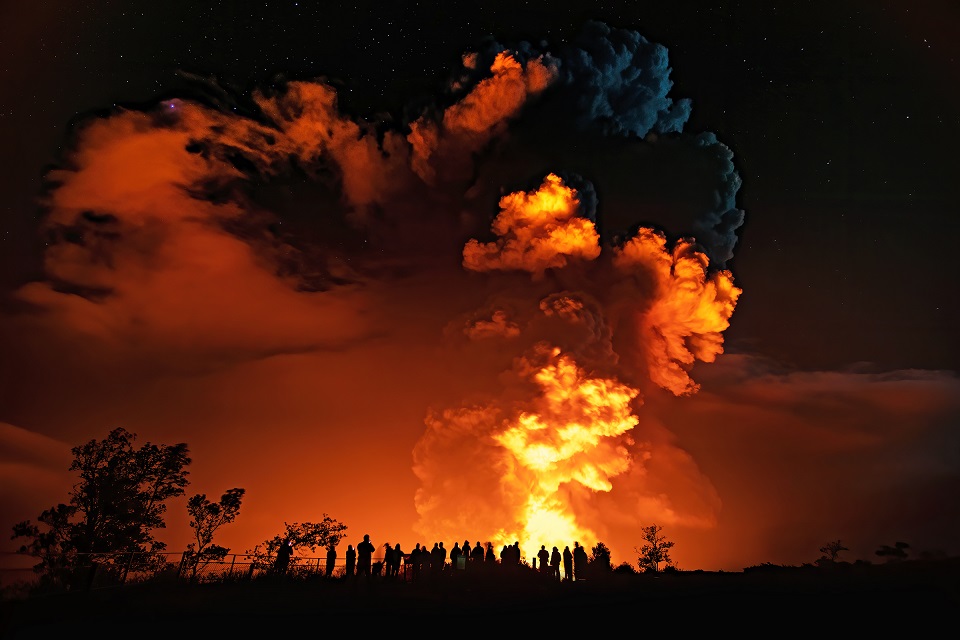News Release

NPS Photo/Janice Wei
|
Subscribe
|
Contact: Jessica Ferracane, 808-985-6018
Hawaii National Park, HAWAI‘I – A spectacular new eruption at the summit of Kīlauea volcano is drawing hundreds of visitors to Hawaiʻi Volcanoes National Park eager to see the billowing plume of gas and steam by day and the reflection of glowing lava deep within the crater after dark. The park remains open 24 hours a day, and the public is reminded to stay safe by following these precautions:• Volcanic eruptions can be hazardous and change at any time. Stay on marked trails and overlooks, and avoid earth cracks and cliff edges. Do not enter closed areas.
• Hazardous volcanic gases are billowing out the crater and present a danger to everyone, especially people with heart or respiratory problems, infants, young children and pregnant women.
• Slow down and drive safely. Expect long waits for parking spaces at popular vantage points like Kīlauea Overlook.
• Maintain social distance of six feet from others and wear a mask to reduce the spread of COVID-19.
• At 1,219 meters, (4,000 feet), the summit of Kīlauea can be chilly at any time. Bring a rain jacket, wear long pants and closed-toe shoes.
“The return of lava to the summit of Kīlauea is a natural wonder, but we need the public to be fully aware that we are in the middle of the COVID-19 pandemic and to recreate responsibily, maintain social distance and to wear a mask,” said Hawaiʻi Volcanoes National Park Superintendent Rhonda Loh. “We want to keep the park open for all to experience this new phase of volcanic activity, and we need visitors to follow safety guidelines that keep everyone safe. We continue to work with USGS scientists to receive the latest volcanic updates, and remind visitors that the eruptive activity and accessiblility could change at any time,” Loh said.
Shortly after 9:30 p.m. HST on Sunday, December 20, the USGS Hawaiian Volcano Observatory (HVO) detected glow within Halmemaʻumaʻu Crater at the summit of Kīlauea volcano, heralding a new eruption. Multiple fissures opened on the crater walls, and lava cascaded into the water lake, boiling it away. Lava fountains were observed on USGS webcams, with the tallest at 50 meters (165 feet). It is the first time lava has been present on the island of Hawaiʻi since the dramatic 2018 Lower East Rift Zone eruption and summit collapse at Kīlauea.
USGS HVO has elevated the Kīlauea volcano alert level to WARNING and its aviation color code to RED. USGS detected a magnitude-4.4 earthquake 14 kilometers (8.7 miles) beneath the volcano’s south flank on Sunday at 10:36 p.m.
All areas that were open in the park before the new eruption began remain open. Vantage points for viewing the new eruption include Wahinekapu (Steaming Bluff), Kīlauea Overlook, Keanakākoʻi, Waldron Ledge and other overlooks along Crater Rim Trail. Nāhuku (Thurston Lava Tube) remains closed due to COVID-19 concerns.
About the National Park Service. More than 20,000 National Park Service employees care for America’s 423 national parks and work with communities across the nation to help preserve local history and create close-to-home recreational opportunities. Learn more at www.nps.gov, and on Facebook, Instagram, Twitter, and YouTube.
Last updated: March 18, 2021
